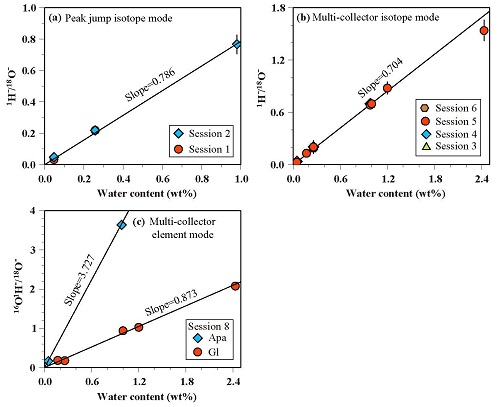
Water plays an important role in the evolution of Earth, Mars, the Moon and other planets, and hydrogen isotopes can be used as a crucial tracer for fractionation processes and water reservoirs. For Martian and Lunar samples, there are two ways to study the interior water content of their parent bodies. One is measuring the water content of apatite (a major hydrous mineral in extraterrestrial samples) to calculate the water content in the parent magmas based on the water partition coefficient between apatite and the melt. The other is to measure the water content of silicate glasses in the melt inclusions, which are usually captured by early crystallized minerals (e.g. olivine). In order to make inferences on the water content of parent bodies with these data, we need to establish a method to measure the water content and H isotopes in apatite and silicate glasses.
Associate professor HU Sen and his colleagues at the Institute of Geology and Geophysics, Chinese Academy of Sciences (IGGCAS), have established three kinds of analytical modes (peak jump isotope mode, multi-collector isotope mode, and multi-collector element mode) to determine the water content and hydrogen isotopes in apatite and silicate glasses using NanoSIMS 50L. Using long term repeated measurements they were able to decrease the H background to 5-10 ppm based on improvements in sample preparation and optimizing the analytical parameters of primary beam current and dwell time. The analytical precisions of the water content and hydrogen isotopes are lower than 6.9% and 45‰ (2SD), respectively.
Furthermore, they also found that the water content calibration slopes of apatite and silicate glasses depended on the analytical modes. In the two isotope modes, apatite and silicate glasses share the same water content calibration slope (Fig. 1a and 1b). In contrast, the water content calibration slope of apatite is significantly higher than that of silicate glasses in multi-collector element mode (Fig. 1c). This method can be used to study the interior water contents of planetary bodies such as Earth, Mars and the Moon.

Fig. 1 Apatite and silicate glasses share the same water content calibration slope in peak jump isotope modes (a) and multi-collector isotope mode (b). In contrast, the slope of apatite significantly differs from that of silicate glasses in multi-collector element mode (c). (Image by IGGCAS)
of apatite significantly differs from that of silicate glasses in multi-collector element mode (c). (Image by IGGCAS)
This study was published in the international journal of Journal of Analytical Atomic Spectrometry (Hu et al., Measurements of water content and D/H ratio in apatite and silicate glasses using a NanoSIMS 50L. Journal of Analytical Atomic Spectrometry. 2015, 30(4): 967-978).
Contact:
Associate Professor HU Sen
Key Lab of Earth and Planetary Physics, CAS
Beijing NanoSIMS Lab
E-mail: husen@mail.iggcas.ac.cn

86-10-68597521 (day)
86-10-68597289 (night)

52 Sanlihe Rd., Xicheng District,
Beijing, China (100864)

